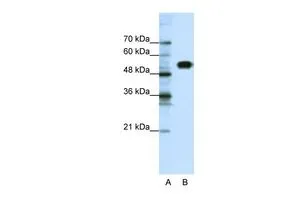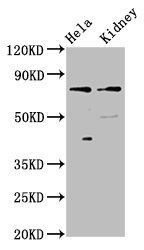
WB analysis of Jurkat cells using GTX47709 CLCNKB antibody at 0.2-1microg/ml. Lane A : Marker Lane B : Jurkat cells
CLCNKB antibody, N-term
GTX47709
Overview
- SupplierGeneTex
- Product NameCLCNKB antibody, N-term
- Delivery Days Customer9
- Application Supplier NoteWB: 0.2-2.5 ug/ml. *Optimal dilutions/concentrations should be determined by the researcher.Not tested in other applications.
- ApplicationsWestern Blot, ImmunoHistoChemistry
- CertificationResearch Use Only
- ClonalityPolyclonal
- Concentration0.5-1 mg/ml
- ConjugateUnconjugated
- Gene ID1188
- Target nameCLCNKB
- Target descriptionchloride voltage-gated channel Kb
- Target synonymschloride channel protein ClC-Kb; chloride channel, kidney, B; chloride channel, voltage-sensitive Kb; ClC-K2; CLCKB; ClC-Kb
- HostRabbit
- IsotypeIgG
- Protein IDP51801
- Protein NameChloride channel protein ClC-Kb
- Scientific DescriptionThe protein encoded by this gene is a member of the family of voltage-gated chloride channels. Chloride channels have several functions, including the regulation of cell volume, membrane potential stabilization, signal transduction and transepithelial transport. This gene is expressed predominantly in the kidney and may be important for renal salt reabsorption. Mutations in this gene are associated with autosomal recessive Bartter syndrome type 3 (BS3). Alternatively spliced transcript variants encoding different isoforms have been found for this gene. [provided by RefSeq, Sep 2009]
- Storage Instruction-20°C or -80°C,2°C to 8°C
- UNSPSC12352203
References
- Second-generation Notch1 activity-trap mouse line (N1IP::CreHI) provides a more comprehensive map of cells experiencing Notch1 activity. Liu Z et al., 2015 Mar 15, DevelopmentRead more



